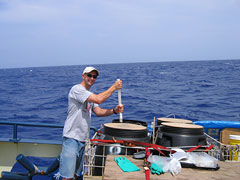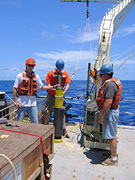

 | |||||||
|
|
Journals 2005/2006James J. Dornicik
July 22, 2005 Today turned out to be a busy day. After several failed attempts to disperse the ST6 with the tracer sled the science team turned to cleaning all the plumbing on the sled system. That continued throughout the day. While certain members of the team cleaned the sled SF6 delivery system I worked with a few other crew members launching CTD scans at 10meters, 20 meters 30meters and 60 meters. These CTD scans were to be used for the Be-7 work. The Be-7 experiment involves treating 200 liters of sea water taken from varying depths with Iron Chloride and Ammonium Hydroxide to precipitate out Iron Hydroxide. The Iron Hydroxide traps the Be-7 whose concentration are later examined.
The event of the day involved the launch of an EM-APEX (ElectroMagnetic, Automatic, Profiler, Explorer). These are the missile like structures see picture. What they do is take the conductivity, temperature, and density measurements along with the horizontal voltage. The way they accomplish this is by plunging themselves down to a specific depth by varying their densities. When they get to their specific depth they alter their density again and float to the surface. They do this every 3 hours and then transmit their data via satellite to computers aboard the ship.
At 20:00 the sled was launched and immediately one of the two pumps shut down. This wasn't a problem due to the fact we could increase the flow the other pump. Once the sled is pumping it is placed at a specific density. The density is determined by a function of the temperature and the salinity of the water. The reason why a specific density is required is due to the fact that most microscopic sea life lives there. The density we were searching for was 26 and it was located at depths from 70 to 100 meters. We continued to monitor the sled until 08:00 the next day. The goal of pumping the SF6 into the water at this specific depth is to determine the vertical mixing that occurs inside an eddy. |
||||||

